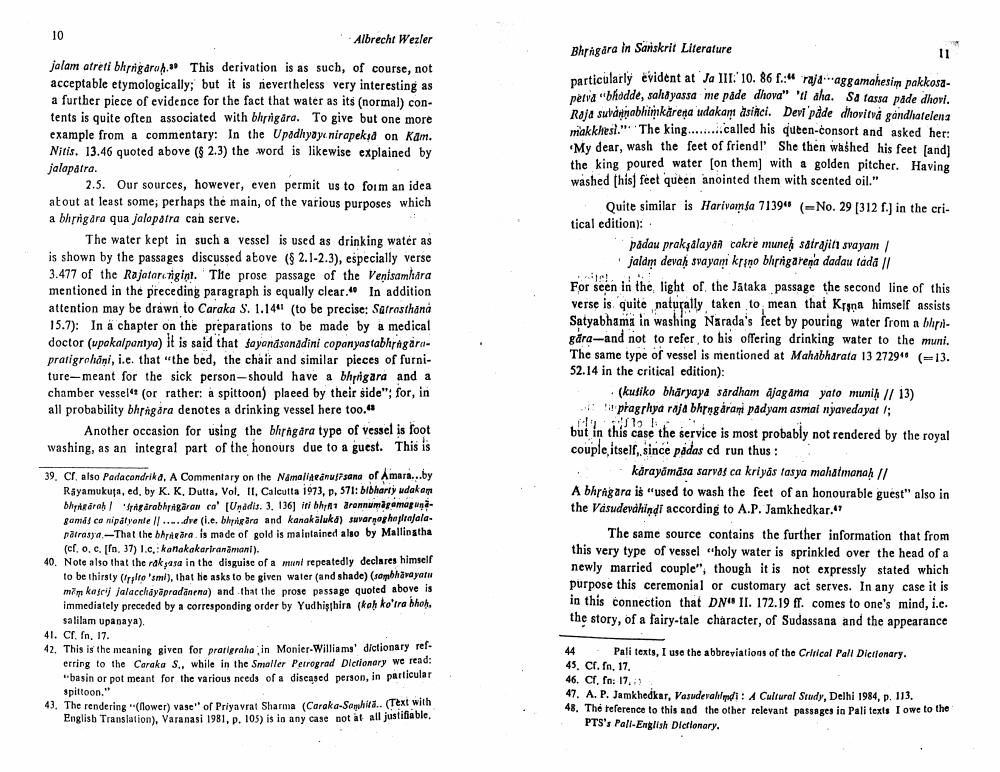Book Title: Bhrngara In Sanskrit Literature Author(s): A Wezler Publisher: A Wezler View full book textPage 6
________________ Albrecht Wezler Bhrigåra in Sanskrit Literature jalam atreti bhrrigara. This derivation is as such, of course, not acceptable etymologically; but it is nevertheless very interesting as a further piece of evidence for the fact that water as its (normal) contents is quite often associated with bhrrigara. To give but one more example from a commentary: In the Upadhyaye nirapeks on kam. Nitis. 13.46 quoted above ($ 2.3) the word is likewise explained by jalapatra. 2.5. Our sources, however, even permit us to form an idea atout at least some; perhaps the main, of the various purposes which a bhrigdra qua jalopatra can serve. The water kept in such a vessel is used as drinking water as is shown by the passages discussed atove ($ 2.1-2.3), especially verse 3.477 of the Rajatarorigin. The prose passage of the Venisamhara mentioned in the preceding paragraph is equally clear. In addition attention may be drawn to Caraka S. 1.144 (to be precise: Sarrasthani 15.7): In a chapter on the preparations to be made by a medical doctor (upakalpantya) it is said that sayanasanadini copanyastabhragaropratigrohani, i.e. that "the bed, the chair and similar pieces of furniture-meant for the sick person should have a bhrigara and a chamber vessel"? (or rather: a spittoon) plaeed by their side"; for, in all probability bhrigăra denotes a drinking vessel here too." Another occasion for using the burngåra type of vessel is foot washing, as an integral part of the honours due to a guest. This is particularly evident at Ja III: 10. 86 .:rajdaggamahesin pakkosapetva bhadde, sahayassa me pade dhova" 'il aha. Sa tassa pade dhovi. Raja suvantabhimkarena udakam asiaci. Devi påde dhovitvå gandhafelena wiakkhel." The king.........called his quten-consort and asked her: My dear, wash the feet of friend! She then washed his feet and the king poured water (on them with a golden pitcher. Having washed this feet queen anointed them with scented oil." Quite similar is Harivarsa 7139" (No. 29 [312 r.) in the critical edition): padau prakşalayan cakre muneh satrajiti svayam/ jaldm devah svayam krsno bhrrigarena dadau tada II For seen in the light of the Jataka passage the second line of this verse is quite naturally taken to mean that Krona himself assists Satyabhama in washing Narada's feet by pouring water from a bhupalgara--and not to refer to his offering drinking water to the muni. The same type of vessel is mentioned at Mahabharata 13 2729 (-13. 52.14 in the critical edition): (kusiko bhāryayd särdham ajagama yato munin // 13) pragrhya raja bhrngárani padyam asmai nyavedayati; but in this case the service is most probably not rendered by the royal couple itself, since padas cd run thus : karayomāsa sarvas ca kriyas tasya mahatmanah 11 A bhragara is used to wash the feet of an honourable guest" also in the Vasudevahindi according to A.P. Jamkhedkar." The same source contains the further information that from this very type of vessel "holy water is sprinkled over the head of a newly married couple", though it is not expressly stated which purpose this ceremonial or customary act serves. In any case it is in this connection that DN II. 172.19 ff. comes to one's mind, i.e. the story, of a fairy-tale character, of Sudassana and the appearance 39. Cr, also Padacandrika. A Commentary on the Namalienuisana of Amara...by Rayamukuta, ed. by K. K, Dutta, Vol. II, Calcutta 1973, p. 571: bibharty udakom bhynkarah/ friedrabhagaran ca' (Unadis. 3. 136) it byna arannumagaman gamdca nipälvente // .....dve (ie, bhreära and kanakaluka) suvarnoghepliafala. pirasy -That the brearais made of gold is maintained also by Mallinstha (cl. o. c. [fn. 37) 1.c. kanakakariranamani). 40. Note also that the rakjasa in the disguise of a mund repeatedly declares himself to be thirsty Urlto'smi), that he asks to be given water and shade) (sambhavayari mim kafcij jalacchayāpradaneno) and that the prose passage quoted above is immediately preceded by a corresponding order by Yudhistira (kah ko'tra bhoh. salilam upapaya). 41. Cf. fn, 17. 42. This is the meaning given for pratigraha in Monier-Williams' dictionary ref erring to the Caraka S., while in the smaller Petrograd Dictionary we read: basin or pot meant for the various needs of a diseased person, in particular Spittoon." 43. The rendering (flower) vasc'' of Priyavrat Sharma (Caraka-Sanhia.. (Text with English Translation), Varanasi 1981, p. 105) is in any case not at all justiciable. 44 Pali texts, I use the abbreviations of the Critical Pall Dictionary. 45. Cf. fn, 17. 46. CT, fn: 17. 47. A. P. Jamkhedkar, Vasudevahid: A Cultural Study, Delhi 1984, p. 113. 48. The teserence to this and the other relevant passages in Pali texts I owe to the PTS's Pali-English Dictionary.Page Navigation
1 ... 4 5 6 7 8 9 10 11 12 13 14 15 16 17 18 19 20 21 22 23
